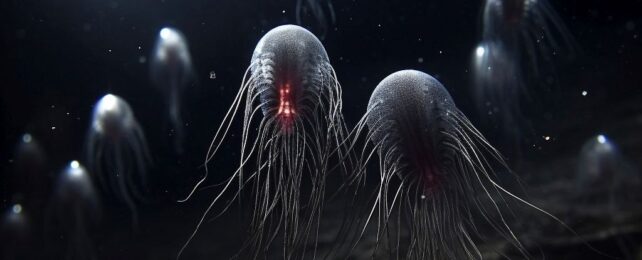
Traces of molecules found in ancient rocks are revealing a wild ecosystem of early life that hunted and thrived in the world's oceans for nearly a billion years.
Biomarker signatures found in rocks dated to 1.64 billion years ago were left by an entire range of previously unknown organisms that dominated life on Earth, in a low-oxygen world an eon before the emergence of plants, animals, and fungi.
These organisms were unlike anything alive today; their discoverers, led by paleobiogeochemists Jochen Brocks and Benjamin Nettersheim of the Australian National University in Australia, have collectively named them the protosterol biota.
They could be the world's earliest predators, feasting on microbes abundant in the oceans at that time; and they also appear to be the ancestors of all eukaryotic life on Earth. That's all the plants, animals and fungi that are around now – including us.
"Molecular remains of the protosterol biota detected in 1.6-billion-year-old rocks appear to be the oldest remnants of our own lineage – they lived even before the Last Eukaryotic Common Ancestor (1.2 billion years ago)," says Nettersheim, who is now at the University of Bremen in Germany.
"These ancient creatures were abundant in marine ecosystems across the world and probably shaped ecosystems for much of Earth's history."

Because eukaryotic life – organisms whose cells contain a nucleus – is so dominant today, scientists think that it must have emerged more than a billion years ago.
Paleobiologists have been on the lookout for these early eukaryotes for a long time, but identification of ancient organisms is challenging at best. Since it's been more than a billion years since they lived, any traces they may have left behind are likely to be extremely degraded, and difficult to confidently diagnose.
The discovery was made analyzing rocks from waterways around the world, the oldest of which were from the Barney Creek Formation in Australia, dating to 1.64 billion years ago.
They were specifically looking for steroids, a biomarker of early eukaryotes first predicted by Nobel laureate biochemist Konrad Bloch in 1994, as nearly all eukaryotes can synthesize steroids, such as cholesterol.

"We employed a combination of techniques to first convert various modern steroids to their fossilized equivalent; otherwise, we wouldn't have even known what to look for," Brocks explains.
He adds, "Scientists had overlooked these molecules for decades because they do not conform to typical molecular search images. Once we knew our target, we discovered that dozens of other rocks, taken from billion-year-old waterways across the world, were oozing with similar fossil molecules."
The discovery shows that these eukaryote biomarkers had been hiding in plain sight all along, although what the creatures that produced them were like remains unknown, since fossils of the creatures themselves have not been found.
However, the researchers believe that the organisms of the protosterol biota were larger and more complex than bacteria, and thrived on them as the next chain up in the food web. "We believe they may have been the first predators on Earth, hunting and devouring bacteria," Brocks says.

Interestingly, the traces left behind by these creatures stopped appearing in the fossil record around 800 million years ago. After this point, algae and fungi begin to appear; the first animals are thought to have emerged about 700 or 600 million years ago.
The decline of the protosterol biota and the emergence of other organisms is known as the Tonian Transformation, and it's one of the most profound alterations Earth's ecology has undergone, allowing for the rise of modern eukaryotes.
The discovery of sterols very similar to those our bodies produce today, in a very different set of organisms, allows us to trace our history back to a time much farther than ever before.
"The highlight of this finding is not just the extension of the current molecular record of eukaryotes," says paleobiogeochemist Christian Hallmann of the German Research Center for Geosciences in Germany.
"Given that the last common ancestor of all modern eukaryotes, including us humans, was likely capable of producing 'regular' modern sterols, chances are high that the eukaryotes responsible for these rare signatures belonged to the stem of the phylogenetic tree."
The research appears in Nature.





No comments:
Post a Comment